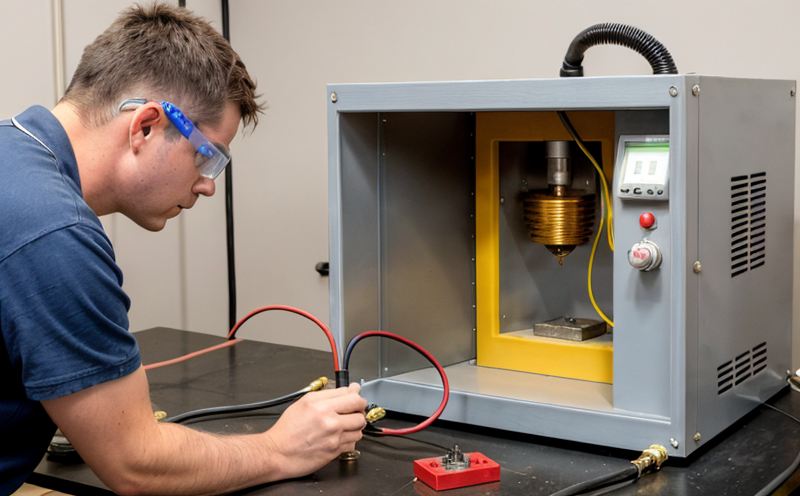ISO 4298 Conductivity Testing of Zinc Alloys
The ISO 4298 standard provides a method to determine the electrical conductivity of zinc and its alloys. This critical test is essential for ensuring that products meet specific quality standards, which is especially important in industries where material integrity directly impacts safety and performance.
Zinc alloys are widely used across various sectors including automotive, aerospace, and construction due to their excellent mechanical properties and corrosion resistance. Conductivity testing helps ensure these materials perform as expected under electrical loads, a necessity for components that require reliable current flow.
The test method involves measuring the resistivity of small cylindrical specimens of the zinc alloy at room temperature using a four-point probe technique. The resistivity is then converted to conductivity by applying the appropriate formula from ISO 4298. This process ensures accurate and repeatable results, crucial for quality control in manufacturing processes.
Proper specimen preparation is vital; this includes ensuring that samples are free from contaminants and are cut into uniform cylinders of a specified diameter and length. The environment where testing occurs must also be controlled to minimize external factors affecting the test results.
The equipment used in ISO 4298 conductivity testing typically consists of a four-point probe system, temperature-controlled chamber, and data acquisition software. The probes ensure precise measurement by minimizing contact resistance while the temperature control is crucial as conductivity can vary significantly with temperature changes.
Once the test has been conducted, the results are compared against specified tolerances defined in ISO 4298. Compliance ensures that products meet customer specifications and industry standards, enhancing product reliability and trustworthiness.
This testing procedure is particularly important for materials engineers involved in R&D, as it provides critical data needed to optimize alloy composition and processing methods. For procurement teams, knowing the results of these tests can help select suppliers who consistently deliver high-quality zinc alloys.
Understanding the nuances of ISO 4298 conductivity testing aids in maintaining product integrity across various applications requiring reliable electrical performance. This service plays a pivotal role in ensuring that products meet stringent quality and reliability requirements, thereby enhancing overall market competitiveness and safety standards.
Industry Applications
| Application Area | Description of Application |
|---|---|
| Aerospace | Zinc alloys are used in the production of lightweight, durable parts for aircraft and spacecraft. Conductivity testing ensures these components can withstand high electrical loads without degradation. |
| Automotive | In automotive manufacturing, zinc alloys contribute to the design of electric vehicles by providing reliable electrical connections that ensure efficient energy transfer. |
| Construction | Zinc-coated steel is used in roofing and structural components. Conductivity testing ensures these materials can handle electrical applications like lightning protection systems effectively. |
| Electrical Engineering | Components made from zinc alloys are crucial for the design of transformers, relays, and other electrical devices where reliability under load is paramount. |
| Application Area | Description of Application |
|---|---|
| Marine Engineering | Zinc anodes are used to protect metal surfaces from corrosion. Conductivity testing ensures the integrity and performance of these anodes under various environmental conditions. |
| Consumer Electronics | In consumer electronics, zinc alloys provide durable casings that can also act as conductors for internal wiring in devices like smartphones and tablets. |
| Refrigeration & Air Conditioning | Zinc is used in the production of heat exchangers. Conductivity testing ensures these components function efficiently under electrical loads, contributing to optimal cooling performance. |
Quality and Reliability Assurance
- ISO 4298 ensures accurate and consistent measurement of zinc alloy conductivity.
- Testing aligns with industry standards, enhancing product reliability.
- Compliance improves customer satisfaction by meeting high-quality benchmarks.
- Data from testing supports continuous improvement in manufacturing processes.
Competitive Advantage and Market Impact
ISO 4298 conductivity testing offers significant competitive advantages. By ensuring that products meet the highest quality standards, companies can differentiate themselves in a crowded market. Reliable zinc alloys contribute to safer, more efficient products which are increasingly sought after by consumers.
The ability to consistently deliver high-quality materials enhances brand reputation and trust among customers. This reliability is especially important for industries where safety and performance are critical.
Moreover, the data obtained from these tests can be used in research and development efforts, leading to innovations that improve product performance and durability. This proactive approach not only strengthens market positioning but also ensures long-term sustainability of operations.





